Validation of PTSD Checklist (PCL-5) for Balinese Community
VerifiedAdded on 2022/08/31
|12
|3566
|26
Report
AI Summary
This report presents a cross-sectional study on the psychometric validation of the PTSD Checklist for DSM-5 (PCL-5) in the Balinese population. The research investigates the reliability, validity, and factor structure of the PCL-5, considering cultural context and trauma related to car accidents. The study aims to assess the internal consistency and inter-rater reliability of the PCL-5, as well as its convergent and construct validity using the Life Events Checklist (LEC) and Quick Inventory of Depressive Symptomatology (QIDS). The researchers hypothesize differences in PTSD severity based on gender, relationship to the deceased, and involvement in the accident. The study involved 301 participants who had lost a relative in a traffic accident, and data were collected through questionnaires and interviews. The findings are expected to contribute to the understanding of PTSD assessment in non-Western societies and the development of culturally appropriate mental health interventions. Cronbach's alpha was used for internal consistency. Factor analysis was used to examine the factor structure of the PCL-5. The study also explores the spiritual beliefs of the Balinese population regarding trauma and soul loss and their impact on PTSD experiences.
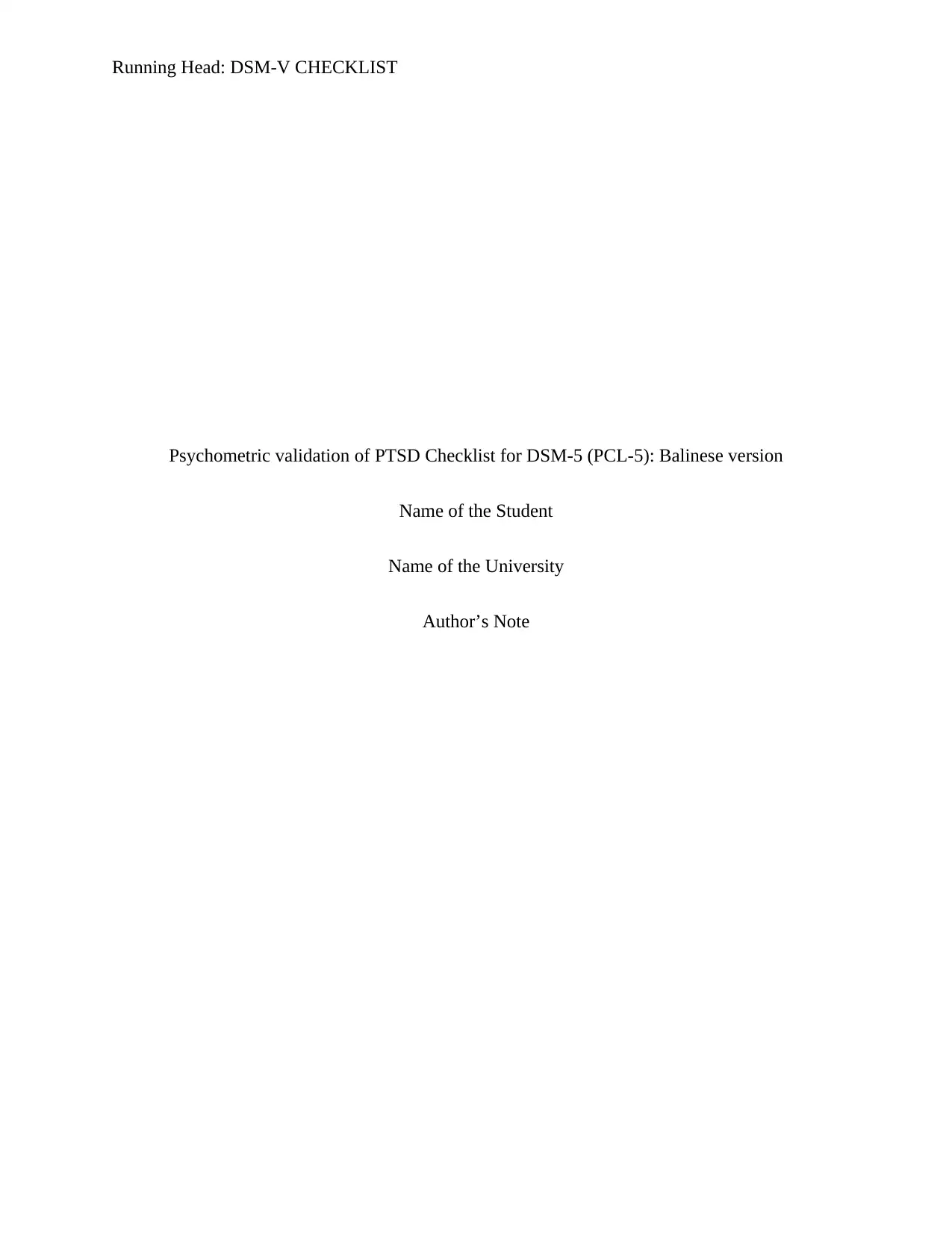
Running Head: DSM-V CHECKLIST
Psychometric validation of PTSD Checklist for DSM-5 (PCL-5): Balinese version
Name of the Student
Name of the University
Author’s Note
Psychometric validation of PTSD Checklist for DSM-5 (PCL-5): Balinese version
Name of the Student
Name of the University
Author’s Note
Paraphrase This Document
Need a fresh take? Get an instant paraphrase of this document with our AI Paraphraser
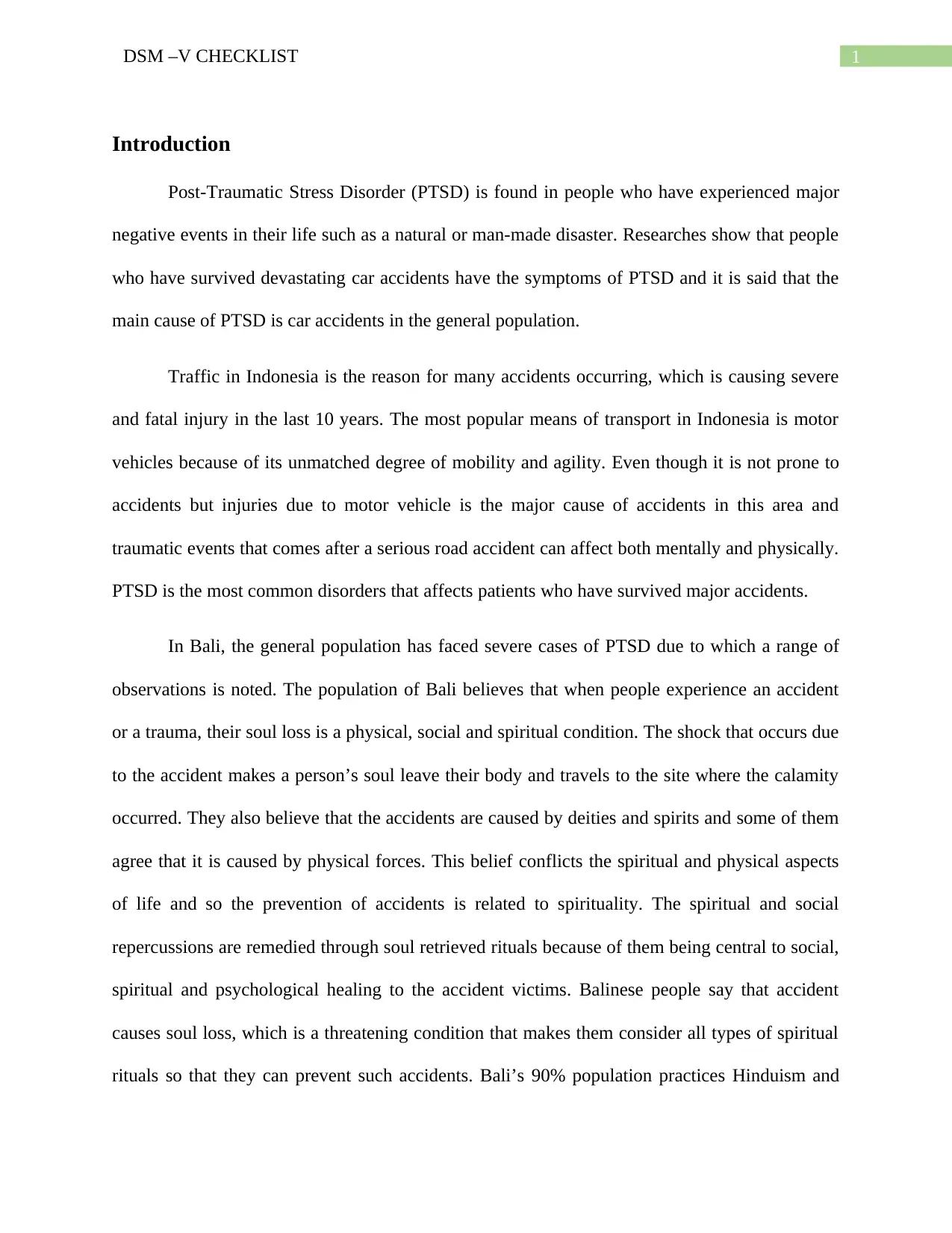
1DSM –V CHECKLIST
Introduction
Post-Traumatic Stress Disorder (PTSD) is found in people who have experienced major
negative events in their life such as a natural or man-made disaster. Researches show that people
who have survived devastating car accidents have the symptoms of PTSD and it is said that the
main cause of PTSD is car accidents in the general population.
Traffic in Indonesia is the reason for many accidents occurring, which is causing severe
and fatal injury in the last 10 years. The most popular means of transport in Indonesia is motor
vehicles because of its unmatched degree of mobility and agility. Even though it is not prone to
accidents but injuries due to motor vehicle is the major cause of accidents in this area and
traumatic events that comes after a serious road accident can affect both mentally and physically.
PTSD is the most common disorders that affects patients who have survived major accidents.
In Bali, the general population has faced severe cases of PTSD due to which a range of
observations is noted. The population of Bali believes that when people experience an accident
or a trauma, their soul loss is a physical, social and spiritual condition. The shock that occurs due
to the accident makes a person’s soul leave their body and travels to the site where the calamity
occurred. They also believe that the accidents are caused by deities and spirits and some of them
agree that it is caused by physical forces. This belief conflicts the spiritual and physical aspects
of life and so the prevention of accidents is related to spirituality. The spiritual and social
repercussions are remedied through soul retrieved rituals because of them being central to social,
spiritual and psychological healing to the accident victims. Balinese people say that accident
causes soul loss, which is a threatening condition that makes them consider all types of spiritual
rituals so that they can prevent such accidents. Bali’s 90% population practices Hinduism and
Introduction
Post-Traumatic Stress Disorder (PTSD) is found in people who have experienced major
negative events in their life such as a natural or man-made disaster. Researches show that people
who have survived devastating car accidents have the symptoms of PTSD and it is said that the
main cause of PTSD is car accidents in the general population.
Traffic in Indonesia is the reason for many accidents occurring, which is causing severe
and fatal injury in the last 10 years. The most popular means of transport in Indonesia is motor
vehicles because of its unmatched degree of mobility and agility. Even though it is not prone to
accidents but injuries due to motor vehicle is the major cause of accidents in this area and
traumatic events that comes after a serious road accident can affect both mentally and physically.
PTSD is the most common disorders that affects patients who have survived major accidents.
In Bali, the general population has faced severe cases of PTSD due to which a range of
observations is noted. The population of Bali believes that when people experience an accident
or a trauma, their soul loss is a physical, social and spiritual condition. The shock that occurs due
to the accident makes a person’s soul leave their body and travels to the site where the calamity
occurred. They also believe that the accidents are caused by deities and spirits and some of them
agree that it is caused by physical forces. This belief conflicts the spiritual and physical aspects
of life and so the prevention of accidents is related to spirituality. The spiritual and social
repercussions are remedied through soul retrieved rituals because of them being central to social,
spiritual and psychological healing to the accident victims. Balinese people say that accident
causes soul loss, which is a threatening condition that makes them consider all types of spiritual
rituals so that they can prevent such accidents. Bali’s 90% population practices Hinduism and
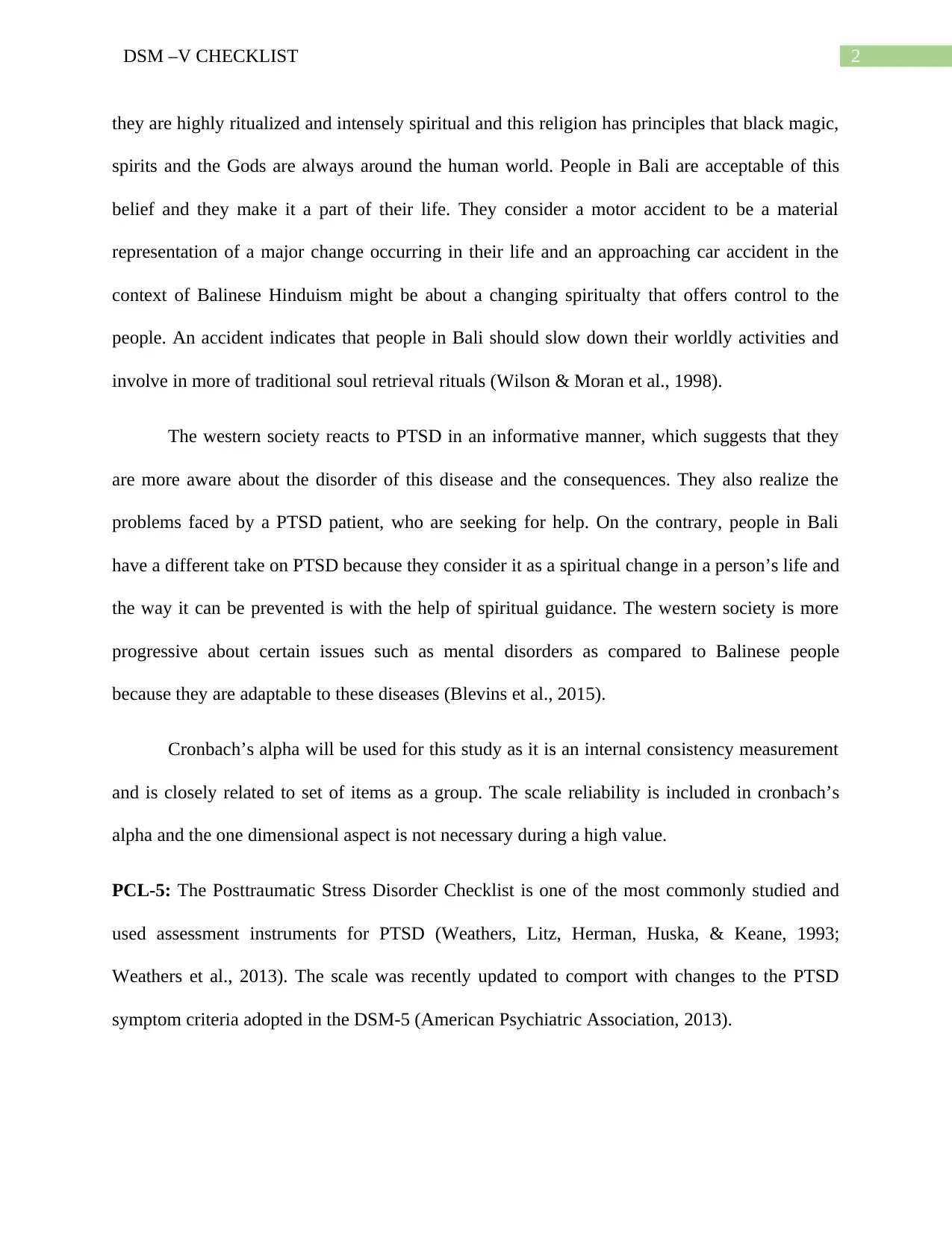
2DSM –V CHECKLIST
they are highly ritualized and intensely spiritual and this religion has principles that black magic,
spirits and the Gods are always around the human world. People in Bali are acceptable of this
belief and they make it a part of their life. They consider a motor accident to be a material
representation of a major change occurring in their life and an approaching car accident in the
context of Balinese Hinduism might be about a changing spiritualty that offers control to the
people. An accident indicates that people in Bali should slow down their worldly activities and
involve in more of traditional soul retrieval rituals (Wilson & Moran et al., 1998).
The western society reacts to PTSD in an informative manner, which suggests that they
are more aware about the disorder of this disease and the consequences. They also realize the
problems faced by a PTSD patient, who are seeking for help. On the contrary, people in Bali
have a different take on PTSD because they consider it as a spiritual change in a person’s life and
the way it can be prevented is with the help of spiritual guidance. The western society is more
progressive about certain issues such as mental disorders as compared to Balinese people
because they are adaptable to these diseases (Blevins et al., 2015).
Cronbach’s alpha will be used for this study as it is an internal consistency measurement
and is closely related to set of items as a group. The scale reliability is included in cronbach’s
alpha and the one dimensional aspect is not necessary during a high value.
PCL-5: The Posttraumatic Stress Disorder Checklist is one of the most commonly studied and
used assessment instruments for PTSD (Weathers, Litz, Herman, Huska, & Keane, 1993;
Weathers et al., 2013). The scale was recently updated to comport with changes to the PTSD
symptom criteria adopted in the DSM-5 (American Psychiatric Association, 2013).
they are highly ritualized and intensely spiritual and this religion has principles that black magic,
spirits and the Gods are always around the human world. People in Bali are acceptable of this
belief and they make it a part of their life. They consider a motor accident to be a material
representation of a major change occurring in their life and an approaching car accident in the
context of Balinese Hinduism might be about a changing spiritualty that offers control to the
people. An accident indicates that people in Bali should slow down their worldly activities and
involve in more of traditional soul retrieval rituals (Wilson & Moran et al., 1998).
The western society reacts to PTSD in an informative manner, which suggests that they
are more aware about the disorder of this disease and the consequences. They also realize the
problems faced by a PTSD patient, who are seeking for help. On the contrary, people in Bali
have a different take on PTSD because they consider it as a spiritual change in a person’s life and
the way it can be prevented is with the help of spiritual guidance. The western society is more
progressive about certain issues such as mental disorders as compared to Balinese people
because they are adaptable to these diseases (Blevins et al., 2015).
Cronbach’s alpha will be used for this study as it is an internal consistency measurement
and is closely related to set of items as a group. The scale reliability is included in cronbach’s
alpha and the one dimensional aspect is not necessary during a high value.
PCL-5: The Posttraumatic Stress Disorder Checklist is one of the most commonly studied and
used assessment instruments for PTSD (Weathers, Litz, Herman, Huska, & Keane, 1993;
Weathers et al., 2013). The scale was recently updated to comport with changes to the PTSD
symptom criteria adopted in the DSM-5 (American Psychiatric Association, 2013).
⊘ This is a preview!⊘
Do you want full access?
Subscribe today to unlock all pages.

Trusted by 1+ million students worldwide
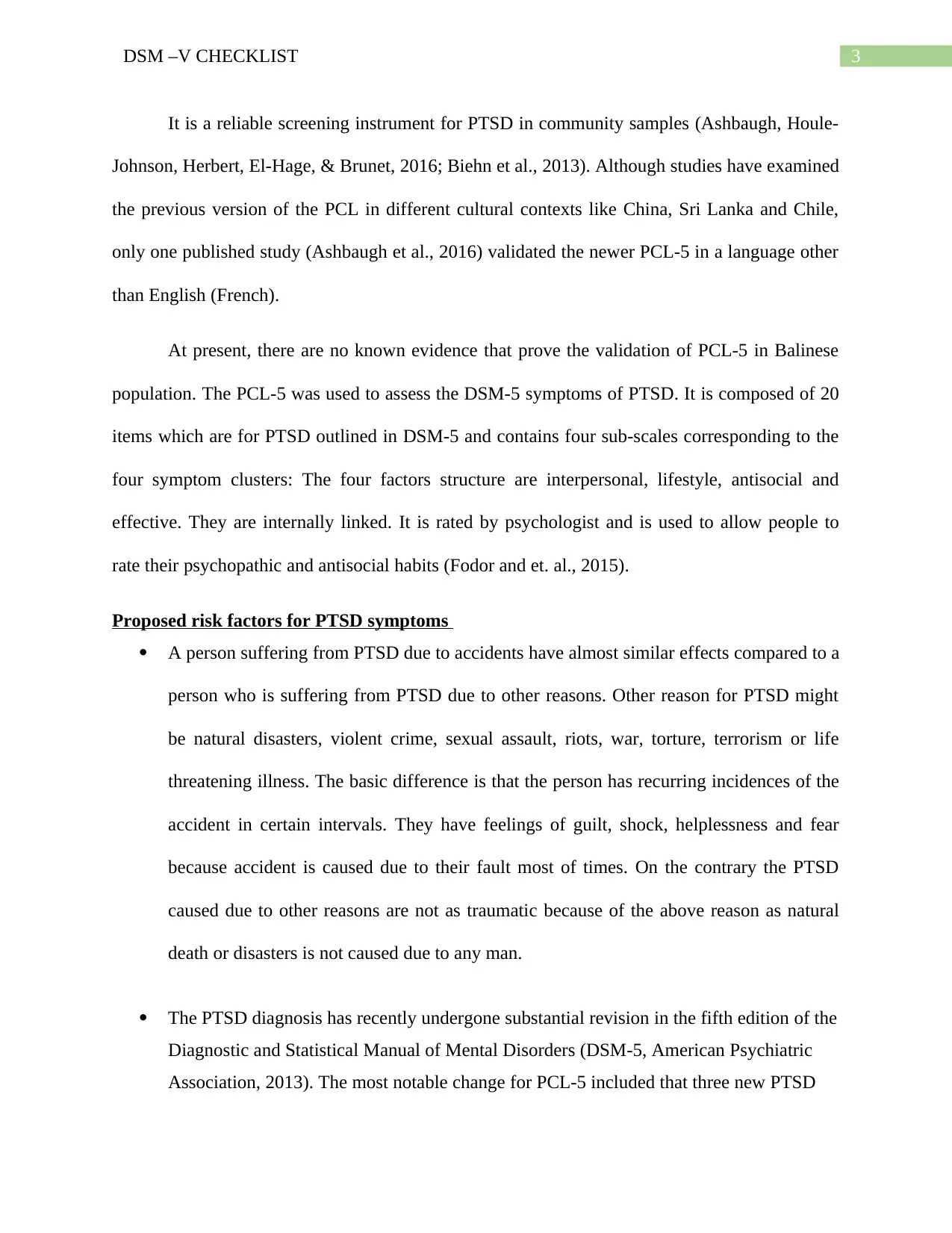
3DSM –V CHECKLIST
It is a reliable screening instrument for PTSD in community samples (Ashbaugh, Houle-
Johnson, Herbert, El-Hage, & Brunet, 2016; Biehn et al., 2013). Although studies have examined
the previous version of the PCL in different cultural contexts like China, Sri Lanka and Chile,
only one published study (Ashbaugh et al., 2016) validated the newer PCL-5 in a language other
than English (French).
At present, there are no known evidence that prove the validation of PCL-5 in Balinese
population. The PCL-5 was used to assess the DSM-5 symptoms of PTSD. It is composed of 20
items which are for PTSD outlined in DSM-5 and contains four sub-scales corresponding to the
four symptom clusters: The four factors structure are interpersonal, lifestyle, antisocial and
effective. They are internally linked. It is rated by psychologist and is used to allow people to
rate their psychopathic and antisocial habits (Fodor and et. al., 2015).
Proposed risk factors for PTSD symptoms
A person suffering from PTSD due to accidents have almost similar effects compared to a
person who is suffering from PTSD due to other reasons. Other reason for PTSD might
be natural disasters, violent crime, sexual assault, riots, war, torture, terrorism or life
threatening illness. The basic difference is that the person has recurring incidences of the
accident in certain intervals. They have feelings of guilt, shock, helplessness and fear
because accident is caused due to their fault most of times. On the contrary the PTSD
caused due to other reasons are not as traumatic because of the above reason as natural
death or disasters is not caused due to any man.
The PTSD diagnosis has recently undergone substantial revision in the fifth edition of the
Diagnostic and Statistical Manual of Mental Disorders (DSM-5, American Psychiatric
Association, 2013). The most notable change for PCL-5 included that three new PTSD
It is a reliable screening instrument for PTSD in community samples (Ashbaugh, Houle-
Johnson, Herbert, El-Hage, & Brunet, 2016; Biehn et al., 2013). Although studies have examined
the previous version of the PCL in different cultural contexts like China, Sri Lanka and Chile,
only one published study (Ashbaugh et al., 2016) validated the newer PCL-5 in a language other
than English (French).
At present, there are no known evidence that prove the validation of PCL-5 in Balinese
population. The PCL-5 was used to assess the DSM-5 symptoms of PTSD. It is composed of 20
items which are for PTSD outlined in DSM-5 and contains four sub-scales corresponding to the
four symptom clusters: The four factors structure are interpersonal, lifestyle, antisocial and
effective. They are internally linked. It is rated by psychologist and is used to allow people to
rate their psychopathic and antisocial habits (Fodor and et. al., 2015).
Proposed risk factors for PTSD symptoms
A person suffering from PTSD due to accidents have almost similar effects compared to a
person who is suffering from PTSD due to other reasons. Other reason for PTSD might
be natural disasters, violent crime, sexual assault, riots, war, torture, terrorism or life
threatening illness. The basic difference is that the person has recurring incidences of the
accident in certain intervals. They have feelings of guilt, shock, helplessness and fear
because accident is caused due to their fault most of times. On the contrary the PTSD
caused due to other reasons are not as traumatic because of the above reason as natural
death or disasters is not caused due to any man.
The PTSD diagnosis has recently undergone substantial revision in the fifth edition of the
Diagnostic and Statistical Manual of Mental Disorders (DSM-5, American Psychiatric
Association, 2013). The most notable change for PCL-5 included that three new PTSD
Paraphrase This Document
Need a fresh take? Get an instant paraphrase of this document with our AI Paraphraser
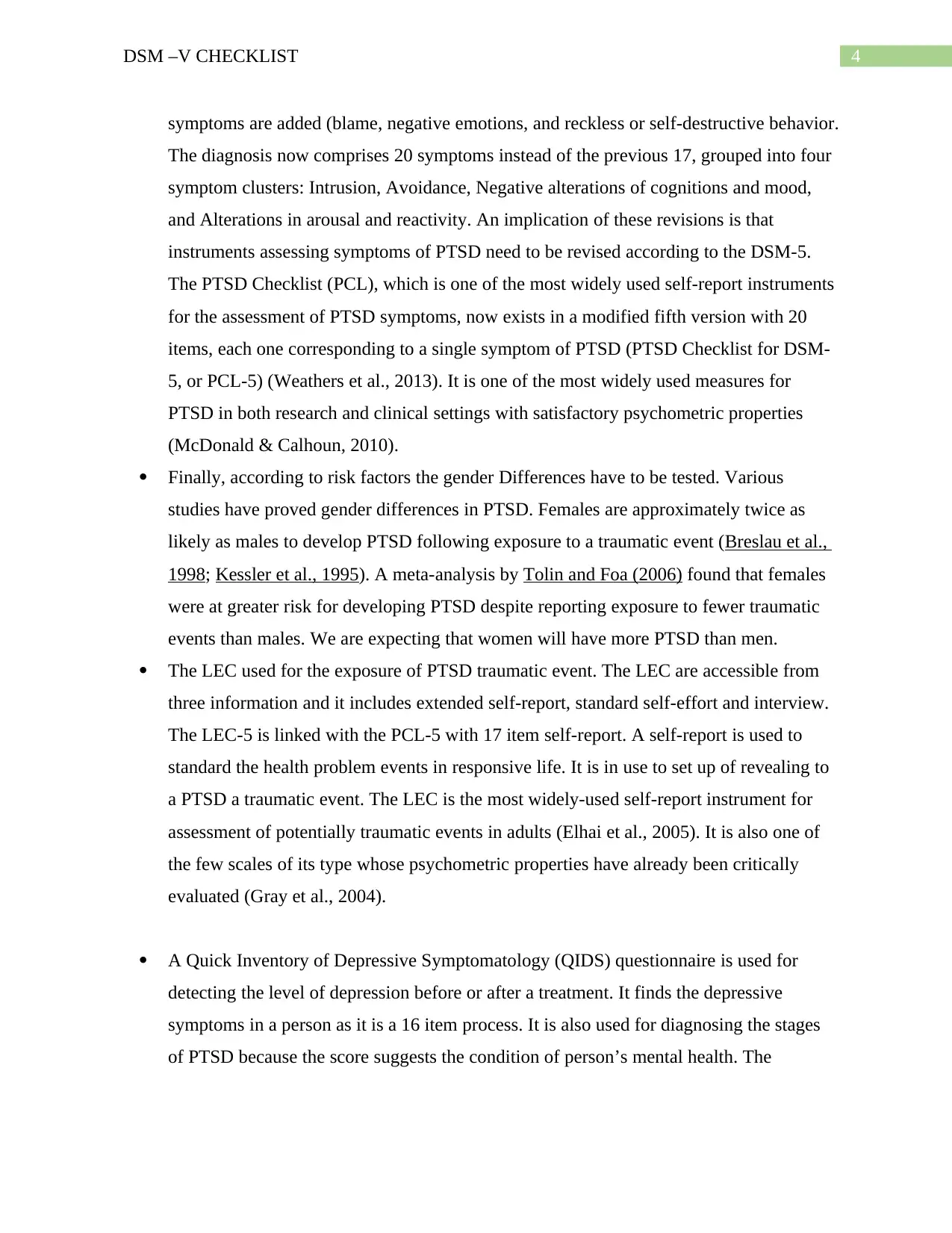
4DSM –V CHECKLIST
symptoms are added (blame, negative emotions, and reckless or self‐destructive behavior.
The diagnosis now comprises 20 symptoms instead of the previous 17, grouped into four
symptom clusters: Intrusion, Avoidance, Negative alterations of cognitions and mood,
and Alterations in arousal and reactivity. An implication of these revisions is that
instruments assessing symptoms of PTSD need to be revised according to the DSM-5.
The PTSD Checklist (PCL), which is one of the most widely used self-report instruments
for the assessment of PTSD symptoms, now exists in a modified fifth version with 20
items, each one corresponding to a single symptom of PTSD (PTSD Checklist for DSM-
5, or PCL-5) (Weathers et al., 2013). It is one of the most widely used measures for
PTSD in both research and clinical settings with satisfactory psychometric properties
(McDonald & Calhoun, 2010).
Finally, according to risk factors the gender Differences have to be tested. Various
studies have proved gender differences in PTSD. Females are approximately twice as
likely as males to develop PTSD following exposure to a traumatic event (Breslau et al.,
1998; Kessler et al., 1995). A meta-analysis by Tolin and Foa (2006) found that females
were at greater risk for developing PTSD despite reporting exposure to fewer traumatic
events than males. We are expecting that women will have more PTSD than men.
The LEC used for the exposure of PTSD traumatic event. The LEC are accessible from
three information and it includes extended self-report, standard self-effort and interview.
The LEC-5 is linked with the PCL-5 with 17 item self-report. A self-report is used to
standard the health problem events in responsive life. It is in use to set up of revealing to
a PTSD a traumatic event. The LEC is the most widely-used self-report instrument for
assessment of potentially traumatic events in adults (Elhai et al., 2005). It is also one of
the few scales of its type whose psychometric properties have already been critically
evaluated (Gray et al., 2004).
A Quick Inventory of Depressive Symptomatology (QIDS) questionnaire is used for
detecting the level of depression before or after a treatment. It finds the depressive
symptoms in a person as it is a 16 item process. It is also used for diagnosing the stages
of PTSD because the score suggests the condition of person’s mental health. The
symptoms are added (blame, negative emotions, and reckless or self‐destructive behavior.
The diagnosis now comprises 20 symptoms instead of the previous 17, grouped into four
symptom clusters: Intrusion, Avoidance, Negative alterations of cognitions and mood,
and Alterations in arousal and reactivity. An implication of these revisions is that
instruments assessing symptoms of PTSD need to be revised according to the DSM-5.
The PTSD Checklist (PCL), which is one of the most widely used self-report instruments
for the assessment of PTSD symptoms, now exists in a modified fifth version with 20
items, each one corresponding to a single symptom of PTSD (PTSD Checklist for DSM-
5, or PCL-5) (Weathers et al., 2013). It is one of the most widely used measures for
PTSD in both research and clinical settings with satisfactory psychometric properties
(McDonald & Calhoun, 2010).
Finally, according to risk factors the gender Differences have to be tested. Various
studies have proved gender differences in PTSD. Females are approximately twice as
likely as males to develop PTSD following exposure to a traumatic event (Breslau et al.,
1998; Kessler et al., 1995). A meta-analysis by Tolin and Foa (2006) found that females
were at greater risk for developing PTSD despite reporting exposure to fewer traumatic
events than males. We are expecting that women will have more PTSD than men.
The LEC used for the exposure of PTSD traumatic event. The LEC are accessible from
three information and it includes extended self-report, standard self-effort and interview.
The LEC-5 is linked with the PCL-5 with 17 item self-report. A self-report is used to
standard the health problem events in responsive life. It is in use to set up of revealing to
a PTSD a traumatic event. The LEC is the most widely-used self-report instrument for
assessment of potentially traumatic events in adults (Elhai et al., 2005). It is also one of
the few scales of its type whose psychometric properties have already been critically
evaluated (Gray et al., 2004).
A Quick Inventory of Depressive Symptomatology (QIDS) questionnaire is used for
detecting the level of depression before or after a treatment. It finds the depressive
symptoms in a person as it is a 16 item process. It is also used for diagnosing the stages
of PTSD because the score suggests the condition of person’s mental health. The
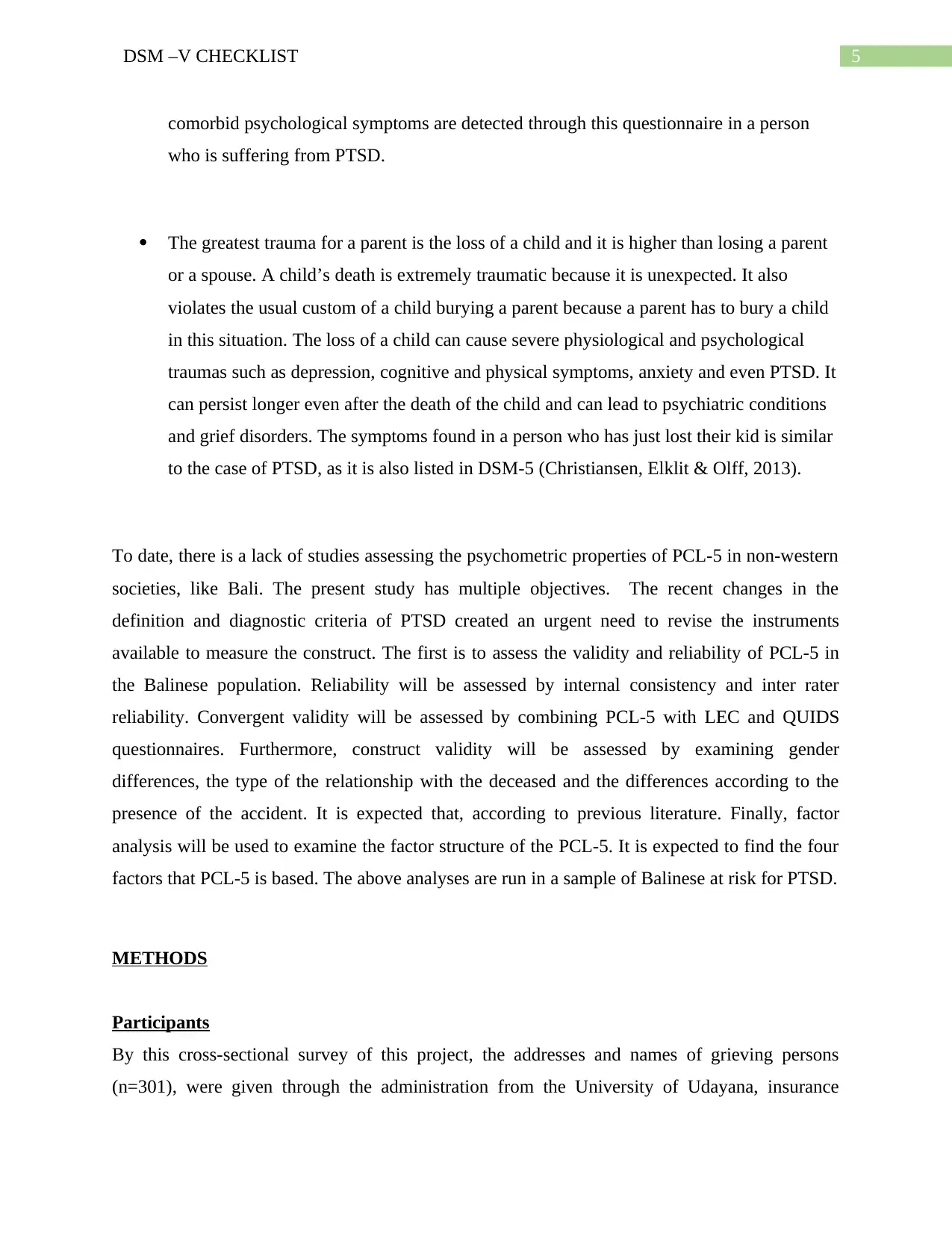
5DSM –V CHECKLIST
comorbid psychological symptoms are detected through this questionnaire in a person
who is suffering from PTSD.
The greatest trauma for a parent is the loss of a child and it is higher than losing a parent
or a spouse. A child’s death is extremely traumatic because it is unexpected. It also
violates the usual custom of a child burying a parent because a parent has to bury a child
in this situation. The loss of a child can cause severe physiological and psychological
traumas such as depression, cognitive and physical symptoms, anxiety and even PTSD. It
can persist longer even after the death of the child and can lead to psychiatric conditions
and grief disorders. The symptoms found in a person who has just lost their kid is similar
to the case of PTSD, as it is also listed in DSM-5 (Christiansen, Elklit & Olff, 2013).
To date, there is a lack of studies assessing the psychometric properties of PCL-5 in non-western
societies, like Bali. The present study has multiple objectives. The recent changes in the
definition and diagnostic criteria of PTSD created an urgent need to revise the instruments
available to measure the construct. The first is to assess the validity and reliability of PCL-5 in
the Balinese population. Reliability will be assessed by internal consistency and inter rater
reliability. Convergent validity will be assessed by combining PCL-5 with LEC and QUIDS
questionnaires. Furthermore, construct validity will be assessed by examining gender
differences, the type of the relationship with the deceased and the differences according to the
presence of the accident. It is expected that, according to previous literature. Finally, factor
analysis will be used to examine the factor structure of the PCL-5. It is expected to find the four
factors that PCL-5 is based. The above analyses are run in a sample of Balinese at risk for PTSD.
METHODS
Participants
By this cross-sectional survey of this project, the addresses and names of grieving persons
(n=301), were given through the administration from the University of Udayana, insurance
comorbid psychological symptoms are detected through this questionnaire in a person
who is suffering from PTSD.
The greatest trauma for a parent is the loss of a child and it is higher than losing a parent
or a spouse. A child’s death is extremely traumatic because it is unexpected. It also
violates the usual custom of a child burying a parent because a parent has to bury a child
in this situation. The loss of a child can cause severe physiological and psychological
traumas such as depression, cognitive and physical symptoms, anxiety and even PTSD. It
can persist longer even after the death of the child and can lead to psychiatric conditions
and grief disorders. The symptoms found in a person who has just lost their kid is similar
to the case of PTSD, as it is also listed in DSM-5 (Christiansen, Elklit & Olff, 2013).
To date, there is a lack of studies assessing the psychometric properties of PCL-5 in non-western
societies, like Bali. The present study has multiple objectives. The recent changes in the
definition and diagnostic criteria of PTSD created an urgent need to revise the instruments
available to measure the construct. The first is to assess the validity and reliability of PCL-5 in
the Balinese population. Reliability will be assessed by internal consistency and inter rater
reliability. Convergent validity will be assessed by combining PCL-5 with LEC and QUIDS
questionnaires. Furthermore, construct validity will be assessed by examining gender
differences, the type of the relationship with the deceased and the differences according to the
presence of the accident. It is expected that, according to previous literature. Finally, factor
analysis will be used to examine the factor structure of the PCL-5. It is expected to find the four
factors that PCL-5 is based. The above analyses are run in a sample of Balinese at risk for PTSD.
METHODS
Participants
By this cross-sectional survey of this project, the addresses and names of grieving persons
(n=301), were given through the administration from the University of Udayana, insurance
⊘ This is a preview!⊘
Do you want full access?
Subscribe today to unlock all pages.

Trusted by 1+ million students worldwide
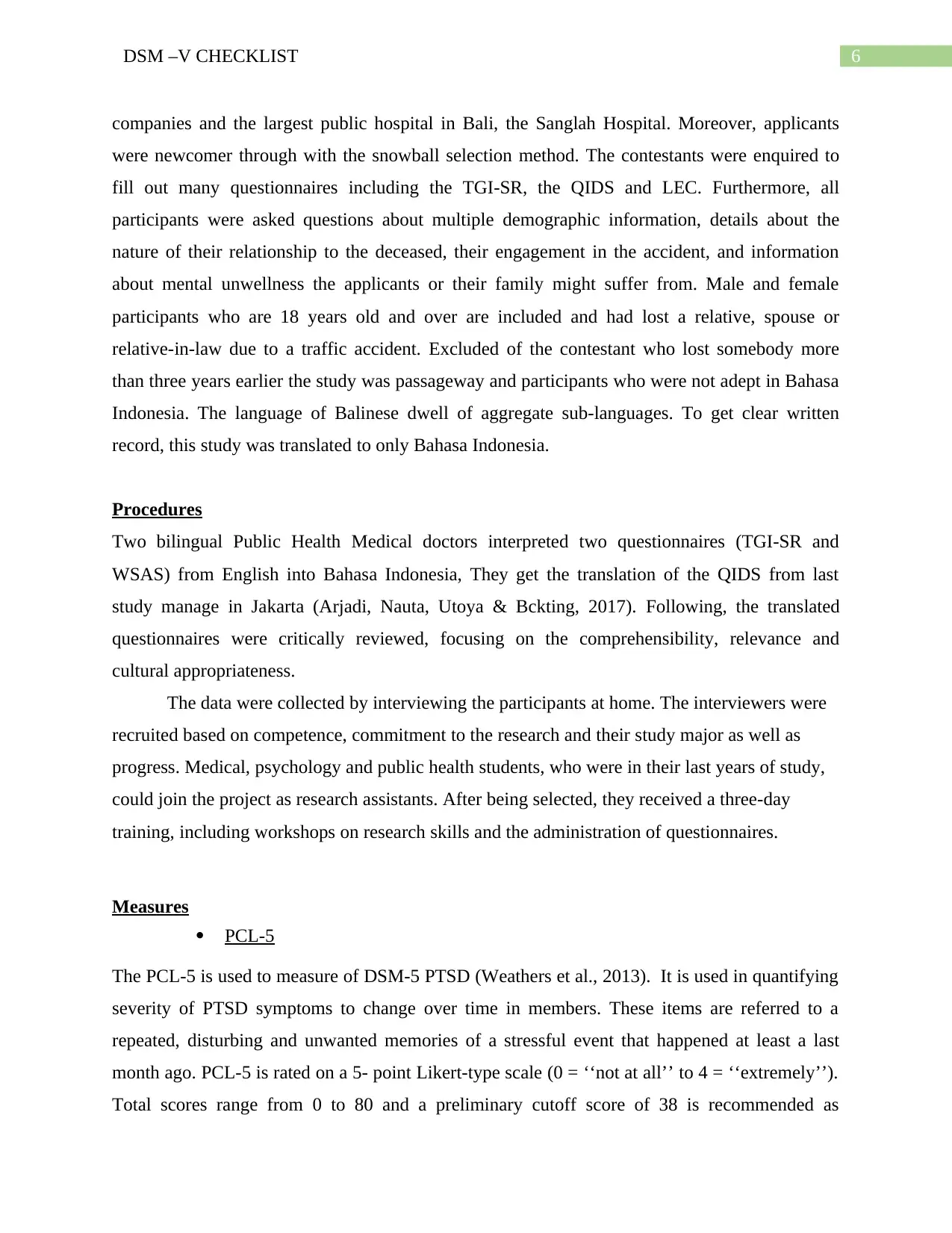
6DSM –V CHECKLIST
companies and the largest public hospital in Bali, the Sanglah Hospital. Moreover, applicants
were newcomer through with the snowball selection method. The contestants were enquired to
fill out many questionnaires including the TGI-SR, the QIDS and LEC. Furthermore, all
participants were asked questions about multiple demographic information, details about the
nature of their relationship to the deceased, their engagement in the accident, and information
about mental unwellness the applicants or their family might suffer from. Male and female
participants who are 18 years old and over are included and had lost a relative, spouse or
relative-in-law due to a traffic accident. Excluded of the contestant who lost somebody more
than three years earlier the study was passageway and participants who were not adept in Bahasa
Indonesia. The language of Balinese dwell of aggregate sub-languages. To get clear written
record, this study was translated to only Bahasa Indonesia.
Procedures
Two bilingual Public Health Medical doctors interpreted two questionnaires (TGI-SR and
WSAS) from English into Bahasa Indonesia, They get the translation of the QIDS from last
study manage in Jakarta (Arjadi, Nauta, Utoya & Bckting, 2017). Following, the translated
questionnaires were critically reviewed, focusing on the comprehensibility, relevance and
cultural appropriateness.
The data were collected by interviewing the participants at home. The interviewers were
recruited based on competence, commitment to the research and their study major as well as
progress. Medical, psychology and public health students, who were in their last years of study,
could join the project as research assistants. After being selected, they received a three-day
training, including workshops on research skills and the administration of questionnaires.
Measures
PCL-5
The PCL-5 is used to measure of DSM-5 PTSD (Weathers et al., 2013). It is used in quantifying
severity of PTSD symptoms to change over time in members. These items are referred to a
repeated, disturbing and unwanted memories of a stressful event that happened at least a last
month ago. PCL-5 is rated on a 5- point Likert-type scale (0 = ‘‘not at all’’ to 4 = ‘‘extremely’’).
Total scores range from 0 to 80 and a preliminary cutoff score of 38 is recommended as
companies and the largest public hospital in Bali, the Sanglah Hospital. Moreover, applicants
were newcomer through with the snowball selection method. The contestants were enquired to
fill out many questionnaires including the TGI-SR, the QIDS and LEC. Furthermore, all
participants were asked questions about multiple demographic information, details about the
nature of their relationship to the deceased, their engagement in the accident, and information
about mental unwellness the applicants or their family might suffer from. Male and female
participants who are 18 years old and over are included and had lost a relative, spouse or
relative-in-law due to a traffic accident. Excluded of the contestant who lost somebody more
than three years earlier the study was passageway and participants who were not adept in Bahasa
Indonesia. The language of Balinese dwell of aggregate sub-languages. To get clear written
record, this study was translated to only Bahasa Indonesia.
Procedures
Two bilingual Public Health Medical doctors interpreted two questionnaires (TGI-SR and
WSAS) from English into Bahasa Indonesia, They get the translation of the QIDS from last
study manage in Jakarta (Arjadi, Nauta, Utoya & Bckting, 2017). Following, the translated
questionnaires were critically reviewed, focusing on the comprehensibility, relevance and
cultural appropriateness.
The data were collected by interviewing the participants at home. The interviewers were
recruited based on competence, commitment to the research and their study major as well as
progress. Medical, psychology and public health students, who were in their last years of study,
could join the project as research assistants. After being selected, they received a three-day
training, including workshops on research skills and the administration of questionnaires.
Measures
PCL-5
The PCL-5 is used to measure of DSM-5 PTSD (Weathers et al., 2013). It is used in quantifying
severity of PTSD symptoms to change over time in members. These items are referred to a
repeated, disturbing and unwanted memories of a stressful event that happened at least a last
month ago. PCL-5 is rated on a 5- point Likert-type scale (0 = ‘‘not at all’’ to 4 = ‘‘extremely’’).
Total scores range from 0 to 80 and a preliminary cutoff score of 38 is recommended as
Paraphrase This Document
Need a fresh take? Get an instant paraphrase of this document with our AI Paraphraser
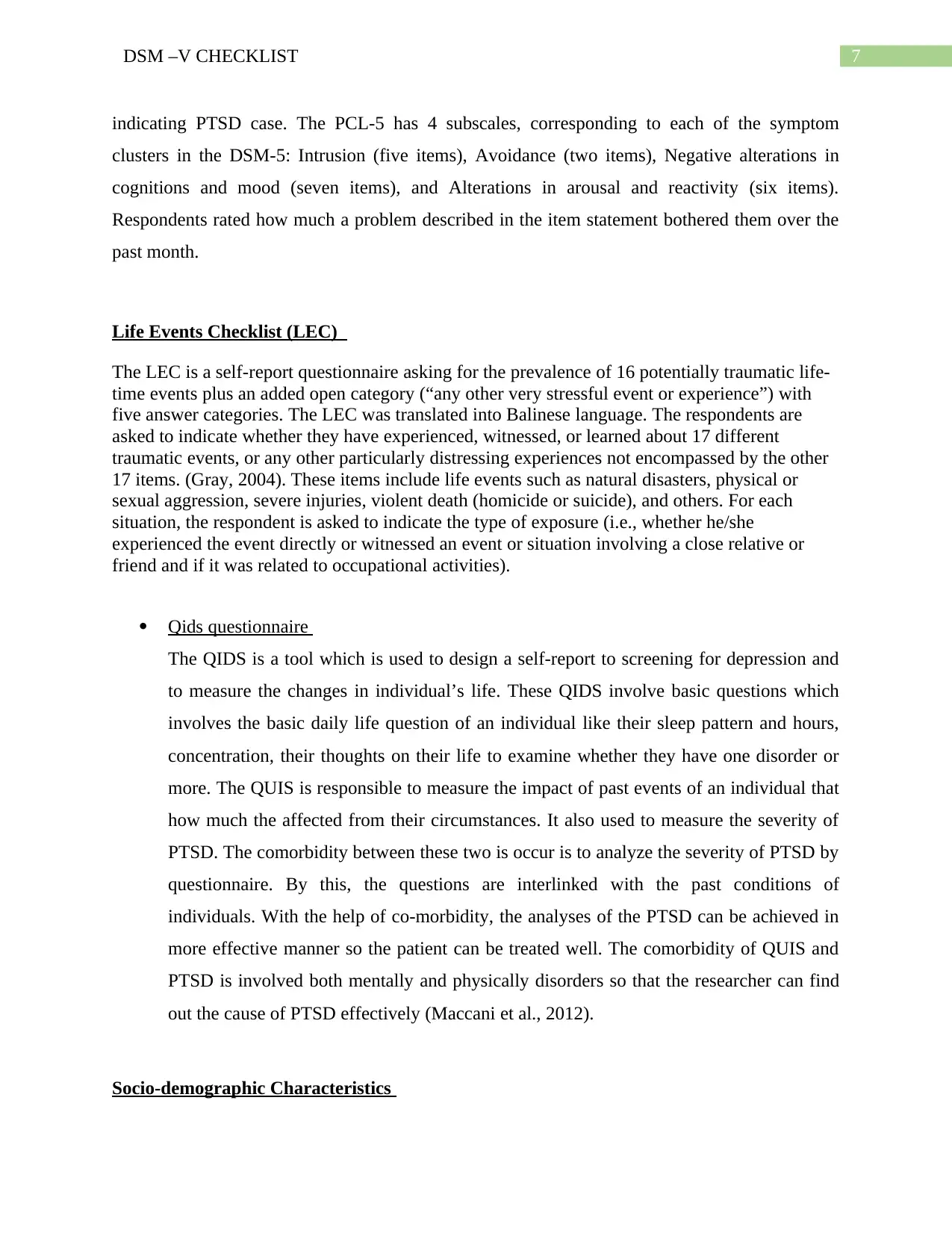
7DSM –V CHECKLIST
indicating PTSD case. The PCL-5 has 4 subscales, corresponding to each of the symptom
clusters in the DSM-5: Intrusion (five items), Avoidance (two items), Negative alterations in
cognitions and mood (seven items), and Alterations in arousal and reactivity (six items).
Respondents rated how much a problem described in the item statement bothered them over the
past month.
Life Events Checklist (LEC)
The LEC is a self-report questionnaire asking for the prevalence of 16 potentially traumatic life-
time events plus an added open category (“any other very stressful event or experience”) with
five answer categories. The LEC was translated into Balinese language. The respondents are
asked to indicate whether they have experienced, witnessed, or learned about 17 different
traumatic events, or any other particularly distressing experiences not encompassed by the other
17 items. (Gray, 2004). These items include life events such as natural disasters, physical or
sexual aggression, severe injuries, violent death (homicide or suicide), and others. For each
situation, the respondent is asked to indicate the type of exposure (i.e., whether he/she
experienced the event directly or witnessed an event or situation involving a close relative or
friend and if it was related to occupational activities).
Qids questionnaire
The QIDS is a tool which is used to design a self-report to screening for depression and
to measure the changes in individual’s life. These QIDS involve basic questions which
involves the basic daily life question of an individual like their sleep pattern and hours,
concentration, their thoughts on their life to examine whether they have one disorder or
more. The QUIS is responsible to measure the impact of past events of an individual that
how much the affected from their circumstances. It also used to measure the severity of
PTSD. The comorbidity between these two is occur is to analyze the severity of PTSD by
questionnaire. By this, the questions are interlinked with the past conditions of
individuals. With the help of co-morbidity, the analyses of the PTSD can be achieved in
more effective manner so the patient can be treated well. The comorbidity of QUIS and
PTSD is involved both mentally and physically disorders so that the researcher can find
out the cause of PTSD effectively (Maccani et al., 2012).
Socio-demographic Characteristics
indicating PTSD case. The PCL-5 has 4 subscales, corresponding to each of the symptom
clusters in the DSM-5: Intrusion (five items), Avoidance (two items), Negative alterations in
cognitions and mood (seven items), and Alterations in arousal and reactivity (six items).
Respondents rated how much a problem described in the item statement bothered them over the
past month.
Life Events Checklist (LEC)
The LEC is a self-report questionnaire asking for the prevalence of 16 potentially traumatic life-
time events plus an added open category (“any other very stressful event or experience”) with
five answer categories. The LEC was translated into Balinese language. The respondents are
asked to indicate whether they have experienced, witnessed, or learned about 17 different
traumatic events, or any other particularly distressing experiences not encompassed by the other
17 items. (Gray, 2004). These items include life events such as natural disasters, physical or
sexual aggression, severe injuries, violent death (homicide or suicide), and others. For each
situation, the respondent is asked to indicate the type of exposure (i.e., whether he/she
experienced the event directly or witnessed an event or situation involving a close relative or
friend and if it was related to occupational activities).
Qids questionnaire
The QIDS is a tool which is used to design a self-report to screening for depression and
to measure the changes in individual’s life. These QIDS involve basic questions which
involves the basic daily life question of an individual like their sleep pattern and hours,
concentration, their thoughts on their life to examine whether they have one disorder or
more. The QUIS is responsible to measure the impact of past events of an individual that
how much the affected from their circumstances. It also used to measure the severity of
PTSD. The comorbidity between these two is occur is to analyze the severity of PTSD by
questionnaire. By this, the questions are interlinked with the past conditions of
individuals. With the help of co-morbidity, the analyses of the PTSD can be achieved in
more effective manner so the patient can be treated well. The comorbidity of QUIS and
PTSD is involved both mentally and physically disorders so that the researcher can find
out the cause of PTSD effectively (Maccani et al., 2012).
Socio-demographic Characteristics
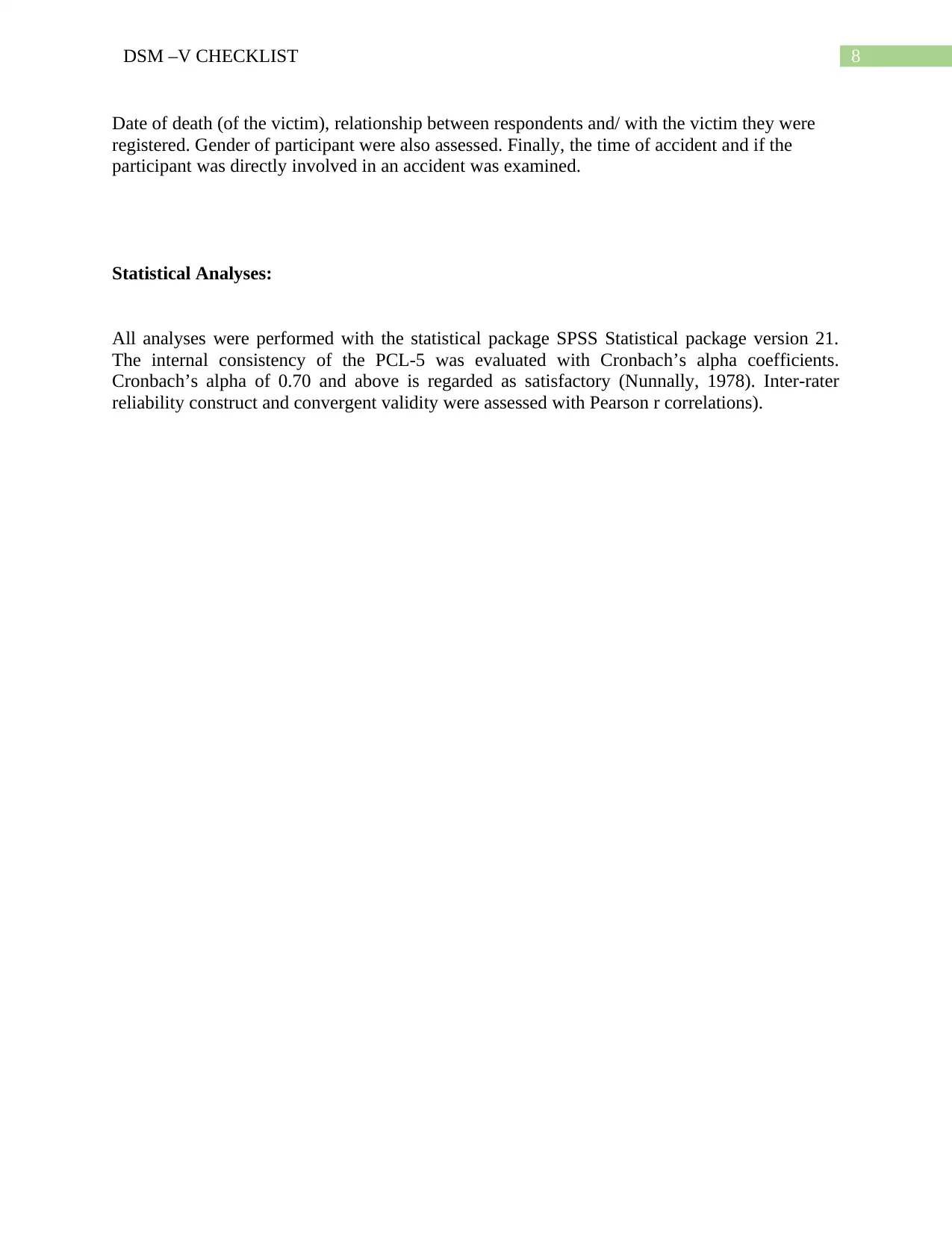
8DSM –V CHECKLIST
Date of death (of the victim), relationship between respondents and/ with the victim they were
registered. Gender of participant were also assessed. Finally, the time of accident and if the
participant was directly involved in an accident was examined.
Statistical Analyses:
All analyses were performed with the statistical package SPSS Statistical package version 21.
The internal consistency of the PCL-5 was evaluated with Cronbach’s alpha coefficients.
Cronbach’s alpha of 0.70 and above is regarded as satisfactory (Nunnally, 1978). Inter-rater
reliability construct and convergent validity were assessed with Pearson r correlations).
Date of death (of the victim), relationship between respondents and/ with the victim they were
registered. Gender of participant were also assessed. Finally, the time of accident and if the
participant was directly involved in an accident was examined.
Statistical Analyses:
All analyses were performed with the statistical package SPSS Statistical package version 21.
The internal consistency of the PCL-5 was evaluated with Cronbach’s alpha coefficients.
Cronbach’s alpha of 0.70 and above is regarded as satisfactory (Nunnally, 1978). Inter-rater
reliability construct and convergent validity were assessed with Pearson r correlations).
⊘ This is a preview!⊘
Do you want full access?
Subscribe today to unlock all pages.

Trusted by 1+ million students worldwide
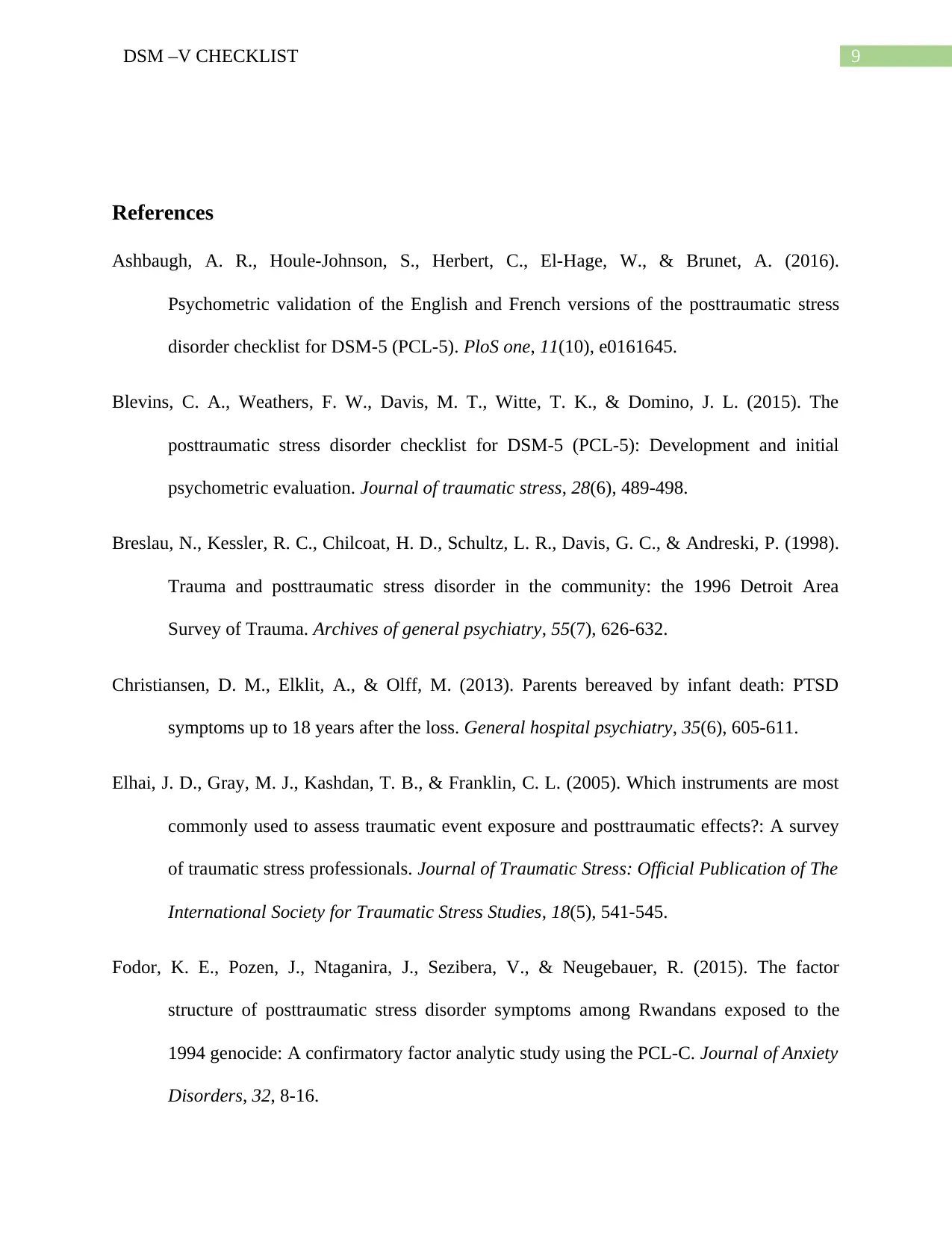
9DSM –V CHECKLIST
References
Ashbaugh, A. R., Houle-Johnson, S., Herbert, C., El-Hage, W., & Brunet, A. (2016).
Psychometric validation of the English and French versions of the posttraumatic stress
disorder checklist for DSM-5 (PCL-5). PloS one, 11(10), e0161645.
Blevins, C. A., Weathers, F. W., Davis, M. T., Witte, T. K., & Domino, J. L. (2015). The
posttraumatic stress disorder checklist for DSM‐5 (PCL‐5): Development and initial
psychometric evaluation. Journal of traumatic stress, 28(6), 489-498.
Breslau, N., Kessler, R. C., Chilcoat, H. D., Schultz, L. R., Davis, G. C., & Andreski, P. (1998).
Trauma and posttraumatic stress disorder in the community: the 1996 Detroit Area
Survey of Trauma. Archives of general psychiatry, 55(7), 626-632.
Christiansen, D. M., Elklit, A., & Olff, M. (2013). Parents bereaved by infant death: PTSD
symptoms up to 18 years after the loss. General hospital psychiatry, 35(6), 605-611.
Elhai, J. D., Gray, M. J., Kashdan, T. B., & Franklin, C. L. (2005). Which instruments are most
commonly used to assess traumatic event exposure and posttraumatic effects?: A survey
of traumatic stress professionals. Journal of Traumatic Stress: Official Publication of The
International Society for Traumatic Stress Studies, 18(5), 541-545.
Fodor, K. E., Pozen, J., Ntaganira, J., Sezibera, V., & Neugebauer, R. (2015). The factor
structure of posttraumatic stress disorder symptoms among Rwandans exposed to the
1994 genocide: A confirmatory factor analytic study using the PCL-C. Journal of Anxiety
Disorders, 32, 8-16.
References
Ashbaugh, A. R., Houle-Johnson, S., Herbert, C., El-Hage, W., & Brunet, A. (2016).
Psychometric validation of the English and French versions of the posttraumatic stress
disorder checklist for DSM-5 (PCL-5). PloS one, 11(10), e0161645.
Blevins, C. A., Weathers, F. W., Davis, M. T., Witte, T. K., & Domino, J. L. (2015). The
posttraumatic stress disorder checklist for DSM‐5 (PCL‐5): Development and initial
psychometric evaluation. Journal of traumatic stress, 28(6), 489-498.
Breslau, N., Kessler, R. C., Chilcoat, H. D., Schultz, L. R., Davis, G. C., & Andreski, P. (1998).
Trauma and posttraumatic stress disorder in the community: the 1996 Detroit Area
Survey of Trauma. Archives of general psychiatry, 55(7), 626-632.
Christiansen, D. M., Elklit, A., & Olff, M. (2013). Parents bereaved by infant death: PTSD
symptoms up to 18 years after the loss. General hospital psychiatry, 35(6), 605-611.
Elhai, J. D., Gray, M. J., Kashdan, T. B., & Franklin, C. L. (2005). Which instruments are most
commonly used to assess traumatic event exposure and posttraumatic effects?: A survey
of traumatic stress professionals. Journal of Traumatic Stress: Official Publication of The
International Society for Traumatic Stress Studies, 18(5), 541-545.
Fodor, K. E., Pozen, J., Ntaganira, J., Sezibera, V., & Neugebauer, R. (2015). The factor
structure of posttraumatic stress disorder symptoms among Rwandans exposed to the
1994 genocide: A confirmatory factor analytic study using the PCL-C. Journal of Anxiety
Disorders, 32, 8-16.
Paraphrase This Document
Need a fresh take? Get an instant paraphrase of this document with our AI Paraphraser
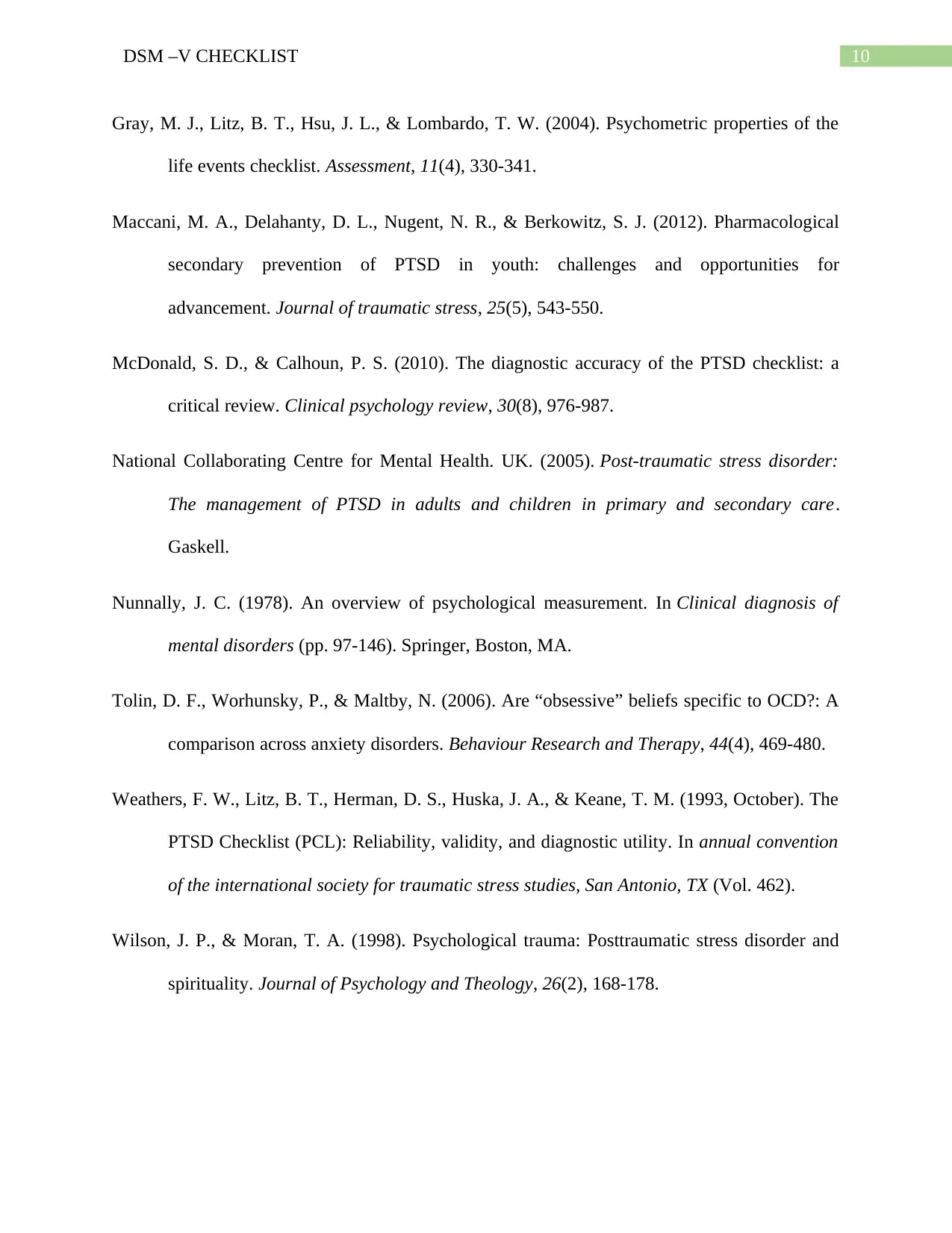
10DSM –V CHECKLIST
Gray, M. J., Litz, B. T., Hsu, J. L., & Lombardo, T. W. (2004). Psychometric properties of the
life events checklist. Assessment, 11(4), 330-341.
Maccani, M. A., Delahanty, D. L., Nugent, N. R., & Berkowitz, S. J. (2012). Pharmacological
secondary prevention of PTSD in youth: challenges and opportunities for
advancement. Journal of traumatic stress, 25(5), 543-550.
McDonald, S. D., & Calhoun, P. S. (2010). The diagnostic accuracy of the PTSD checklist: a
critical review. Clinical psychology review, 30(8), 976-987.
National Collaborating Centre for Mental Health. UK. (2005). Post-traumatic stress disorder:
The management of PTSD in adults and children in primary and secondary care.
Gaskell.
Nunnally, J. C. (1978). An overview of psychological measurement. In Clinical diagnosis of
mental disorders (pp. 97-146). Springer, Boston, MA.
Tolin, D. F., Worhunsky, P., & Maltby, N. (2006). Are “obsessive” beliefs specific to OCD?: A
comparison across anxiety disorders. Behaviour Research and Therapy, 44(4), 469-480.
Weathers, F. W., Litz, B. T., Herman, D. S., Huska, J. A., & Keane, T. M. (1993, October). The
PTSD Checklist (PCL): Reliability, validity, and diagnostic utility. In annual convention
of the international society for traumatic stress studies, San Antonio, TX (Vol. 462).
Wilson, J. P., & Moran, T. A. (1998). Psychological trauma: Posttraumatic stress disorder and
spirituality. Journal of Psychology and Theology, 26(2), 168-178.
Gray, M. J., Litz, B. T., Hsu, J. L., & Lombardo, T. W. (2004). Psychometric properties of the
life events checklist. Assessment, 11(4), 330-341.
Maccani, M. A., Delahanty, D. L., Nugent, N. R., & Berkowitz, S. J. (2012). Pharmacological
secondary prevention of PTSD in youth: challenges and opportunities for
advancement. Journal of traumatic stress, 25(5), 543-550.
McDonald, S. D., & Calhoun, P. S. (2010). The diagnostic accuracy of the PTSD checklist: a
critical review. Clinical psychology review, 30(8), 976-987.
National Collaborating Centre for Mental Health. UK. (2005). Post-traumatic stress disorder:
The management of PTSD in adults and children in primary and secondary care.
Gaskell.
Nunnally, J. C. (1978). An overview of psychological measurement. In Clinical diagnosis of
mental disorders (pp. 97-146). Springer, Boston, MA.
Tolin, D. F., Worhunsky, P., & Maltby, N. (2006). Are “obsessive” beliefs specific to OCD?: A
comparison across anxiety disorders. Behaviour Research and Therapy, 44(4), 469-480.
Weathers, F. W., Litz, B. T., Herman, D. S., Huska, J. A., & Keane, T. M. (1993, October). The
PTSD Checklist (PCL): Reliability, validity, and diagnostic utility. In annual convention
of the international society for traumatic stress studies, San Antonio, TX (Vol. 462).
Wilson, J. P., & Moran, T. A. (1998). Psychological trauma: Posttraumatic stress disorder and
spirituality. Journal of Psychology and Theology, 26(2), 168-178.

11DSM –V CHECKLIST
⊘ This is a preview!⊘
Do you want full access?
Subscribe today to unlock all pages.

Trusted by 1+ million students worldwide
1 out of 12
Your All-in-One AI-Powered Toolkit for Academic Success.
+13062052269
info@desklib.com
Available 24*7 on WhatsApp / Email
![[object Object]](/_next/static/media/star-bottom.7253800d.svg)
Unlock your academic potential
Copyright © 2020–2025 A2Z Services. All Rights Reserved. Developed and managed by ZUCOL.


